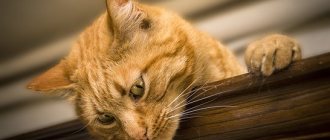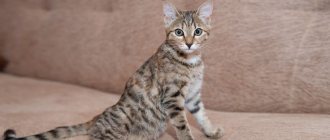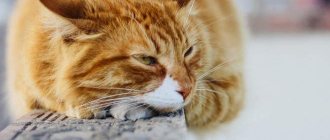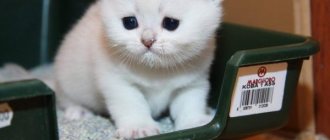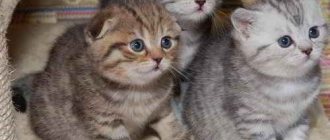Coprostasis in cats - what is it?
The name of the pathology consists of two Greek words: “kopros” (meaning “feces”) and “ktasis” (translated as “stop”). We can say that this is a pathology in which feces cannot move freely along their usual “route” in the intestines, as a result of which they begin to accumulate. This condition causes severe intoxication, which, in turn, is fraught with volvulus and ruptures. Note that as soon as you notice coprostasis in a cat, it must be eliminated immediately.
Causes of pathology in cats
Why does this pathology occur? As a rule, the main reason is related to the cat's poor diet. More precisely, with eating foods that she shouldn’t eat at all. These include: synthetic sausage casings, fish and chicken bones, as well as other garbage. Such waste can completely clog the entire intestinal lumen. But fish bones are capable of breaking through the intestinal walls, which can lead not only to coprostasis in a cat, but also to peritonitis. It also happens that pathology occurs for other reasons. For example, chronic or infectious diseases of the gastrointestinal tract can provoke the appearance of coprostasis. Often these diseases lead to blockage of the bile ducts. As a result, the process of digesting food sharply worsens and intestinal motility decreases. This further leads to the occurrence of coprostasis.
Causes of the phenomenon
Intestinal blockage in cats is divided into several types - mechanical and functional. The mechanical form of intestinal obstruction is characterized by blockage of the lumen due to intussusception or a foreign body getting stuck.
The functional form of intestinal blockage is also called paralytic, which occurs against the background of peritonitis, atony and disorders of the nervous innervation of the intestinal walls. The cause of mechanical blockage can also be coprostasis, helminth infection, foreign bodies in the digestive tract, intussusception, ingestion of large hairballs, compression of the intestinal lumen during tumor processes, as well as an increase in the volume of nearby organs.
All these factors cause blocking of a specific function of the intestine - transporting food. Future feces cannot find a way out, flatulence develops and, as a result, severe intoxication of the body with its own breakdown products.
Functional blockage of the intestine occurs with pathologies of the autonomic part of the nervous system, inflammatory processes in the abdominal cavity, complications during surgical interventions under general anesthesia.
Disruption of the physiological process of food digestion develops against the background of further complications associated with intestinal blockage. Gastric juice, secreted by special glands, is absorbed under normal conditions after the incoming food has dissolved.
But in case of violations, gastric juice accumulates in the small intestine and leads to the eruption of gastric contents. Against this background, dehydration develops.
Impaired blood circulation in the affected area leads to the death of cellular structures and the further development of decomposition processes of intestinal tissue. The process of intoxication of the body accelerates, and the prognosis for possible recovery becomes unfavorable.
Coprostasis
Quite often in veterinary medicine, the main cause of intestinal blockage is chronic constipation. Coprostasis leads to the gradual development of intoxication of the body with breakdown products of substances from food, which turn into toxic substances and penetrate into the systemic bloodstream through the mucous membrane.
Intestinal parasites
In advanced cases, helminthic infestations lead to blockage of the intestinal lumen by a ball of helminths. Having special hooks and suction cups, the parasites injure the intestinal tract and form a ball. When getting rid of parasites using special means, you must be as careful as possible, since dead helminths in large quantities can also clog the intestinal lumen, causing severe intoxication of the body.
Foreign body in the intestine
Domestic cats, especially kittens, are incredibly curious creatures. Often the cause of blockage of the intestinal lumen is a foreign body swallowed by the cat during play. Intestinal obstruction can be caused by plastic bags, threads and New Year's tinsel.
Under the influence of gastric juice, they do not dissolve, penetrate unchanged into the intestines and get stuck there. The use of laxatives is dangerous as it can cause rupture of the intestinal walls. If you suspect that your pet has swallowed a foreign object, you should immediately contact a veterinarian.
Pylobezoar
Trichobezoar or pilobezoar, one name for a hairball formed in the digestive tract of a domestic cat. Cats that naturally have thick and long fur often suffer from this condition. When licking, part of the fur penetrates the mouth and digestive tract.
Large pilobesoars cannot leave the digestive system naturally, which leads to coprostasis and further development of intestinal blockage.
Neoplasms in the intestines
The cause of blockage of the intestines can be malignant or benign neoplasms. As the tumor grows in the intestinal lumen, the symptoms of the pathology will increase. The first signs of tumor formation in the intestines are disturbances in appetite, vomiting and constipation. As the pathology develops, the signs of intestinal blockage become more pronounced.
Other causes of pathology
In kittens, helminths (a large number of them) can clog the intestines. These parasites completely block the lumen of the small intestine. This situation is extremely dangerous, as organ rupture or volvulus may occur. In addition, toxins are absorbed into the cat’s blood.
Another dangerous cause of coprostasis in cats is an intestinal tumor. Even if the formation is benign, it is very large. As a result, complete blockage of the intestinal lumen may occur, which will lead to the death of the animal.
It often happens that pathology occurs in animals that have undergone strip surgery. All this happens because a fairly common side effect of any such intervention is adhesions. If there are a lot of them, they can even crush the intestines. If the operation was performed on the intestines, then it also happens that the connective tissue directly grows into the walls of the organ. This leads to coprostasis in the cat.
Also, a similar pathology often occurs in long-haired animals. When they lick daily, they swallow a lot of fur.
Causes of megacolon in cats
Megacolon in cats can occur at any age; no breed predisposition has been identified. But there are statistics on which animals are more likely to develop megacolon. Most often, cats between 5 and 8 years old are affected. Smooth-haired individuals with megacolon are found in 42-48% of cases. According to statistics, males with megacolon are more common than females, in 65-70% of cases. Obese cats are at risk.
Megacolon in a cat, lateral X-ray
Idiopathic megacolon can develop as a primary disease, without obvious causes. In this case, pathologies of the muscular wall of the intestine and impaired contractility of the colon are observed.
Pain
. Older cats often have joint problems. These problems may cause pain during bowel movements.
Pain can occur when a cat has swallowed a foreign object that has injured the intestinal mucosa.
Intestinal abscesses, inflammation of the paraanal sinuses and inflammation of the anus cause pain during bowel movements.
Metabolic disorders
. A decrease in the amount of potassium and calcium in the blood can lead to impaired intestinal motility. Also, intestinal dysfunction can provoke a decrease in thyroid hormone levels.
Neurological disorders
. Frequent causes of dysfunction of the large intestine are injuries to the lumbar, sacral and caudal spine.
Spinal deformity in Manx cats can cause the development of megacolon.
Colon obstruction
. The development of obstruction is possible with improper fusion of the pelvis after fractures. The presence of tumors, strictures, foreign objects and spasms can also lead to obstruction of the large intestine.
Dehydration (dehydration)
. Loss of fluid, increased urine production, and low water consumption by the cat - all this leads to dehydration of the animal's body. In this case, the formation of dry and hard feces is observed, which provokes constipation and megacolon.
Lifestyle and behavioral characteristics
:
- The cat does not go into the litter box if it is dirty - it is necessary to regularly clean and wash the litter box;
- If there is competition with other cats for the litter box, the cat may not use it;
- Stress (fear) while using the tray can lead to refusal to use the tray in the future;
- The cat does not go into the litter box due to inappropriate litter;
- The tray is in an awkward place.
Coprostasis in cats: diagnosis by clinical signs
What signs indicate the presence of this pathology? How to determine coprostasis in cats? It is quite difficult to suspect this particular pathology. Since the first signs are very similar to severe constipation. The animal begins to grunt convulsively and growl when defecating. As a result of his “efforts,” he either does not succeed at all, or he produces feces in small portions in the form of thin ropes and ribbons. This already indicates that there is something in the animal’s intestines that prevents the normal movement of feces. Subsequently, the animal's condition worsens. The symptoms of coprostasis in the cat become more obvious. You can notice how she carefully pushes during the act of defecation, but at the same time she is unable to “squeeze” anything out. The cat loses its appetite and experiences severe symptoms of intoxication (including coma and neurological seizures). At the same time, she is apathetic and has a hard, bloated stomach.
Diagnostic tests
Although many cases of constipation and megacolon rarely show significant changes in laboratory testing (eg, CBC, chemistry, urinalysis), these tests should be performed in all cats with constipation. In some cases, metabolic causes of constipation are found, such as dehydration, hypokalemia and hypercalcemia. In cats with recurrent constipation and other symptoms consistent with hypothyroidism, baseline serum thyroxine levels and other thyroid function tests should also be performed.
All cats with constipation should have an abdominal x-ray to determine the severity of colonic obstruction and predisposing factors, such as the presence of a radiopaque foreign body (eg, a bone fragment), intra- or extra-intestinal masses, pelvic fractures, and spinal cord disease. . In idiopathic cases, evidence of colonic obstruction on x-ray does not differentiate between constipation, obstipation, and megacolon. In some cats, primary or secondary constipation is sometimes very severe and generalized, but nevertheless resolves with appropriate treatment.
In some cases, additional research is necessary. For tumors outside the intestinal lumen, ultrasound examination of the abdominal cavity and targeted biopsy can be performed, and for tumors inside the intestine, it is best to conduct an endoscopic examination. Colonoscopy may also be used to examine the colon and anorectum for possible inflammatory lesions, stenosis, sacculitis, and diverticulum. If colonoscopy is not possible, contrast radiography can be performed with preliminary introduction of barium into the large intestine. For both colonoscopy and barium enema contrast radiography, the rectum must be carefully cleaned with an enema before general anesthesia. Animals with suspected neurological disorders should undergo cerebrospinal fluid analysis, as well as myelographic and electrophysiological studies. Finally, a colon biopsy or anorectal manometry should be performed to diagnose suspected cases of ganglion megacolon.
First aid if you suspect this pathology
How to provide first aid to a cat if this pathology is suspected? Place the animal on a starvation diet. But do not limit his drinking. Then feed your pet liquid oatmeal with vegetable oil. If problems with slowed peristalsis began due to the fact that the animal is fasting on dry food, then these recommendations will help you solve the problem.
Prevention measures
To prevent digestive disorders, the following recommendations should be followed:
- Brush your pet regularly. It is advisable to use a furminator for this to remove most of the dead hair. During shedding, you can offer your pet special food or paste to remove hair.
- Provide the animal with adequate nutrition. Your diet should include sources of fiber. Do not feed your pet only canned food and pates.
- Water must be freely available. It is better to purchase large bowls, because... the animal can save water.
- Plant special cat grass. It will help cleanse the intestines and stimulate peristalsis.
- Apply flea treatment and deworming every 3-6 months.
- Provide physical activity. Put up a big cat tree, buy toys, and exercise with the animal more often.
Treatment of pathology. What is used for this disease?
Now let's talk about the treatment of coprostasis in cats. How is therapy carried out? It all depends on what caused the illness. Surgery can remove pieces of bone, overgrown adhesions and tumors. Even neoplasms that respond well to chemotherapy simply do not have time to “etch out”, and caked pieces of feces still need to be removed from the intestines. If the pathology occurs due to a large number of helminths, then drugs against parasites are prescribed. Specific therapy will also be required to restore the gastrointestinal tract after illness. In addition, in all cases an enema with oils and Glauber's salt is prescribed. Such procedures soften dehydrated and stagnant pieces of feces. In no case should you immediately prescribe strong laxatives; this is strictly prohibited, since in this case there is a risk of intestinal rupture in the animal.
Treatment of the disease
There are 2 main methods of getting rid of megacolon - surgical and conservative. The choice of therapy depends on the severity of the disease. The main goals of treatment are cleansing the intestines, restoring metabolism and quality hydration. In the early stages, the cat may self-heal.
Drugs against megacolon
Doctors prescribe medications that help improve the passage of stool through the intestines. Vaseline oil has an effective effect. It is best administered rectally to avoid causing aspiration pneumonia. Hypersomatic laxatives (potassium salts, lactulose, polyethylene glycols) help improve metabolism and speed up the movement of food through the body.
The following drugs can be used in the treatment of this disease: Lactulose and Cisapride.
It is safest to use lactulose. It is suitable for all cats. Magnesium salts are contraindicated in individuals who have kidney problems. Glycols negatively affect the health of a cat if it has intestinal obstruction. To improve the functioning of the gastrointestinal tract, prokinetics are used. The drug "Cisapride" will restore your pet's appetite. To cleanse the body, you need to do an enema. If this method does not help, then the feces are removed manually. To do this, the cat is given more fluids and then an anesthetic is administered through an endotracheal tube to reduce discomfort. This will help inject a saline solution into the anus and remove the stones.
The disease can be treated with the following drugs:
- "Ranithiin" (1-2 milligrams per kilogram every 10 hours);
- "Nizatidine" (2-5 mg/kg per day);
- "Tsufulak" (15 mg/kg at 12 o'clock);
- "Duclolax" (5 mg per 24 hours);
- "Laxaton" (1-5 ml per day).
Surgical method
Elimination of the pathology by surgery is necessary when it is severe.
In case of severe stage of the disease, subtotal colectomy is used. This is an operation in which part of the intestine is cut out from the body. The effectiveness of this method depends on the stage of development of the disease. Sometimes after the intervention the cat has loose stools for a month. But this method also gives the cat a better chance of recovery than the drug method. Colonopexy is also performed. This is a surgical procedure in which the intestine is fixed to the abdominal wall. This helps relieve constipation.
Diet for megacolon
It is important that the animal always has access to a tray and bowl of food. To restore water balance, a lot of water is required. The diet should consist of dietary wet food. The food should contain a large amount of fiber and water. This will help it be absorbed faster and pass through the entire body. To restore the animal’s strength, it is recommended to give a complete complex of vitamins and minerals.





